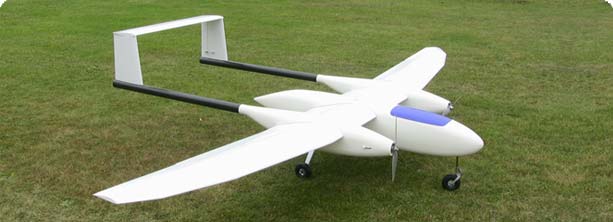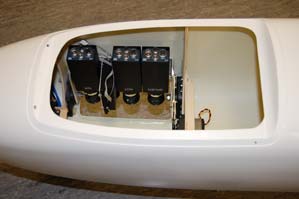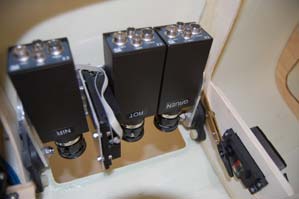
Remote sensing with the UAV "Stuttgart Adler"
The use of a remote-controlled model aircraft is being tested and demonstrated as a remote sensing
platform at the Institute of Space Systems (IRS). For this purpose, the model aircraft "Stuttgart Adler" is equipped with various payloads to carry out scientific missions to determine the bi-directional reflectance distribution function (BRDF) and to collect environmental data. The "Stuttgart Adler" was designed and constructed by students of the Faculty of Aeronautics and Astronautics particularly for its task. It differs from the model aircrafts used by hobby pilots due to the observance of safety-related factors.
The design allows for a large fuselage for the instrumentation, the electric drive system is housed in two engine
nacelles within the wing unit. With a total weight of 25 kilograms, the Stuttgart Adler can carry a payload of about 5 kilograms and achieves a flight time of up to 30 minutes. The flight navigation is carried out through a GPS-based control system that allows the aircraft to take off automatically according to a pre-programmed flight plan.
The main task of the Stuttgart Adler consists of an experiment to determine the bi-directional reflectance distribution function (BRDF). This function describes the reflective properties of a surface depending on the viewing angle of the observer and the angles of the incidence of the beam striking the surface.
The knowledge of the BRDF is relevant for a variety of applications, such as for the processing of satellite images or aerial photos which were taken under different lighting conditions, or for classification of land areas. To obtain the measured data the aircraft has to fly over the survey area in orbits and shoot from different perspectives. For this purpose the payload cameras should be mounted on a pivoting platform in order to align them to the target area under different roll angles. This is implemented by a swiveling device designed and manufactured at the IRS. Due to the extraordinary weight
requirements, the xiros® flange bearings are used here. The polymer ball bearings compensate for misalignment and impress by its very low weight. By the absolute corrosion resistance, it is possible to obtain very accurate measurement data.
The instrumentation of the Stuttgart Adler comprises three cameras for the visible and near infrared spectral range, as well as a spectrometer and a thermal infrared camera. The cameras in the process achieve a ground resolution of up to 10 centimeters in the visible and near infrared spectral range, while a ground resolution of 30 centimeters is achieved in the thermal infrared range.
Advantages of xiros® flange bearings:
Lubricant free
maintenance free
Corrossion-resistant
Lightweight

